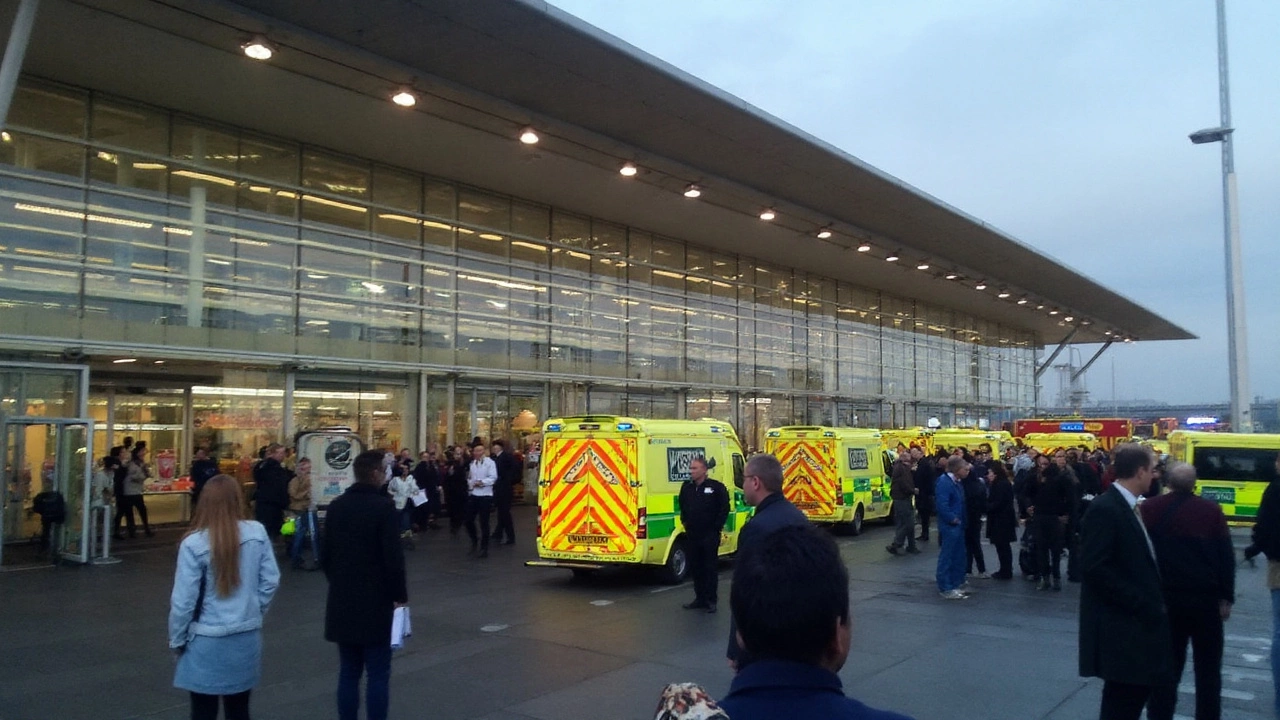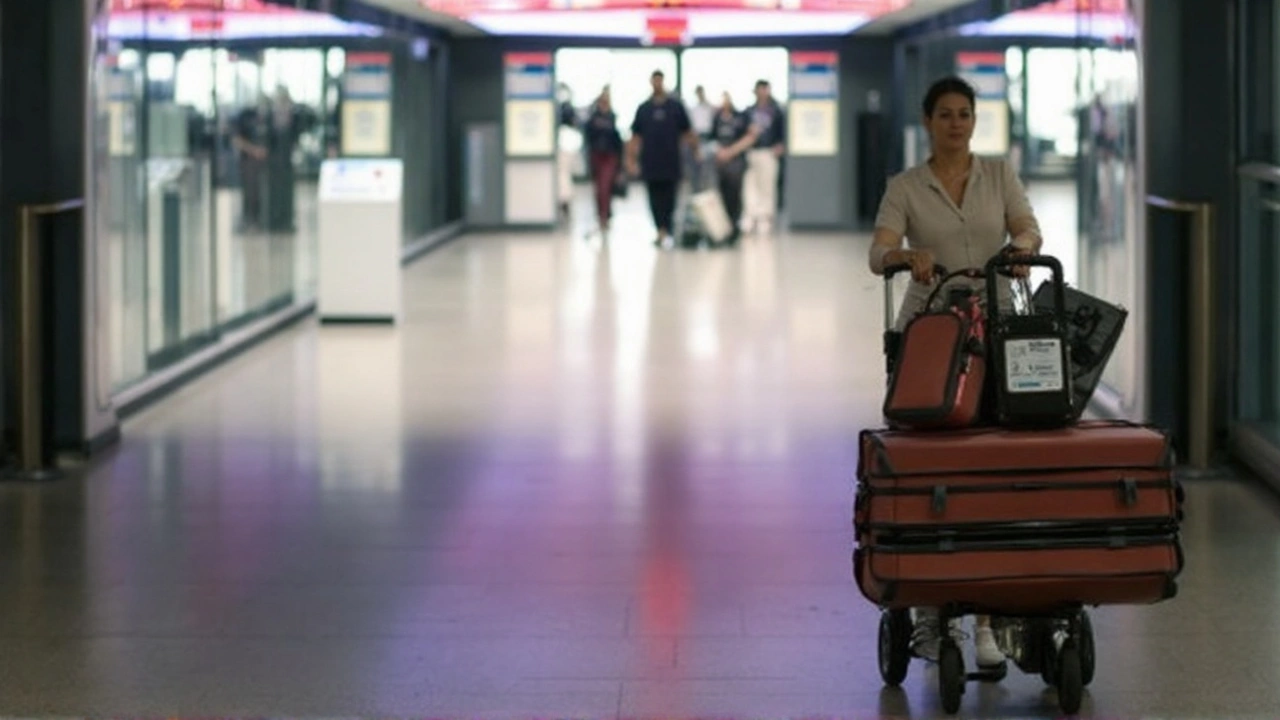Evening peak at Heathrow Airport is a tight dance of departures, connections, and last calls. On Monday, that rhythm froze. Terminal 4 was evacuated for more than three hours after a suspected hazardous materials alert, forcing passengers into the cold, halting check-in, and pushing dozens of flights off schedule. The all-clear came at 8:27 PM, but the knock-on effects lasted deep into the night.
What happened and how the response unfolded
The alert began just before 5:00 PM, right as Terminal 4 was gearing up for one of its busiest windows. Specialist police officers, the London Fire Brigade, and London Ambulance Service moved in within minutes. The fire brigade’s first call came at roughly 5:01 PM. Crews from multiple stations were sent to assess the scene and run hazardous substance checks.
Airport staff cleared the landside check-in hall and moved passengers to the roads outside the terminal. Those already through security stayed airside, where operations could be controlled more easily. A couple of flights whose passengers were already on board were allowed to depart close to schedule. That kept some connections intact, but not many.
With temperatures dropping, staff handed out foil blankets. Passengers described confusion more than panic—people simply didn’t know what they were dealing with, and clear information was slow to land while emergency teams worked. The situation was made harder by London Underground strike action, which had already limited public transport options to the airport.
The ambulance service treated 21 people on site; one person was taken to hospital. Police later said around 20 people reported injuries, none life-threatening or life-changing. In major incidents like this, symptoms can range from anxiety and hyperventilation to irritation caused by cleaning agents or aerosols. Emergency teams run methodical checks to rule out dangerous substances before reopening any space.
After a full sweep, specialist officers and firefighters found no trace of any hazardous material. Once those results were in, Heathrow announced the terminal was safe to reopen at 8:27 PM. Staff then began the slow restart: reopening check-in, reassembling queues, and working through aircraft and crew rescheduling.
Terminal 4 is home to a mix of long-haul and regional flights—particularly carriers serving the Gulf, Middle East, Africa, and parts of Asia. That network amplifies disruption. If flights leave late from London, connections downline don’t line up, and crews can run out of permissible duty hours. One delay at the hub can ripple through multiple continents.

The fallout: delays, missed connections, and what comes next
The disruption was heavy. Dozens of departures were delayed—some by as much as four hours—and the last flights pushed off well after midnight, unusual at an airport that operates under tight night restrictions. Airlines scrambled to rebook missed connections, especially for passengers heading to hub cities in the Gulf and beyond.
For passengers stranded by the timing, the toughest part was the uncertainty. If your flight is delayed but not canceled, you’re stuck in limbo: holding patterns on the pavement outside, then long lines once the doors reopen. Families with kids needed warm spaces and water. Elderly travelers needed seats. Airport staff did the basics—blankets, crowd control, rerouting—but logistics are messy when your check-in hall suddenly becomes a cordon.
Back-end operations had their own hurdles. Aircraft out of position had to be towed or brought back onto gate schedules. Baggage systems needed a reset to prevent bags from being left behind when flights were re-slotted. Crews had to switch duties to stay within legal working hours. Ground handlers, security teams, and airline controllers were all working at once to rebuild the evening program.
So why such a strong response for something that turned out to be nothing? That’s by design. Airports treat any hint of a hazardous substance as real until proven otherwise. Standard playbooks include evacuating landside areas, isolating suspicious zones, and sending in specialists with detection kits. It’s the safest approach, particularly at busy international hubs with a long memory of past incidents worldwide.
The London Fire Brigade is leading the investigation into what triggered the alert. That could take time. In past cases at big terminals, early warnings have been caused by accidental spills, strong fumes from cleaning products, battery failures, or even harmless substances that set off sensors. Until investigators pin down the source, the official line remains simple: no hazardous material was found, and the terminal is safe.
The wider travel picture made the day worse. With parts of the Underground disrupted by strikes, alternatives to get to and from Terminal 4 were already stretched. Road traffic around the airport thickened as the evacuation pushed passengers outside and pick-up points overflowed. When the terminal reopened, the rush back in created a second wave of bottlenecks at security and customer service desks.
If you were due to fly from Terminal 4 last night or early this morning, the advice is straightforward:
- Check your flight status before leaving home. Some schedules will still be off while airlines reposition aircraft and crews.
- If you missed a connection, contact your airline directly. Most carriers prioritize rebooking onto the next available flight, especially for long-haul itineraries.
- Keep your receipts if you incurred expenses. Depending on the airline and the cause of delay, you may be able to claim reasonable costs.
- Arrive earlier than usual today. Queues may be longer as the operation catches up.
For Heathrow, Monday’s shutdown was a reminder of how quickly a normal evening can tilt. Terminal 4 has been steadily building back traffic since it reopened after the pandemic. Many of its carriers operate banks of flights in tight waves—late afternoon and evening departures feeding into overnight long-haul schedules. When one of those waves breaks, the rebuild takes hours, not minutes.
The emergency services’ timeline will be pored over in the days ahead. Expect an internal debrief on communications: when staff paged the first alerts, how instructions were relayed to passengers, and whether signage and public announcements kept up with the evolving situation. Those small details matter when thousands of people are moving at once and information is patchy.
There’s also the question of capacity buffers. On days with transport strikes or heavy weather, airports tend to run closer to the edge. More people arrive early and wait longer, meaning more congestion in the check-in hall and security lanes. When an evacuation hits at that moment, it magnifies the impact on every step of the process—from bag drop to boarding.
By late evening, the scene slowly normalized. Flights began to push back in clumps, and staff worked gate by gate to get people moving. Buses ferried passengers from remote stands. Catering trucks and loaders raced to catch up with the new sequences. It wasn’t pretty, but it worked well enough to get the final departures airborne.
What we do know is clear: the alert started just before 5 PM; emergency teams arrived within minutes; 21 patients were treated, one hospitalized; no hazardous substance was found; and Terminal 4 reopened at 8:27 PM. The investigation continues. For thousands of passengers, the journey simply took a detour.

